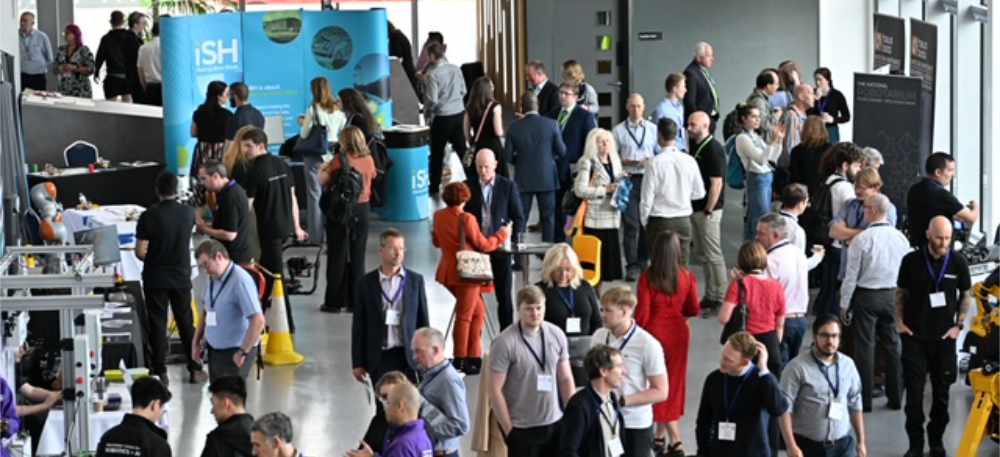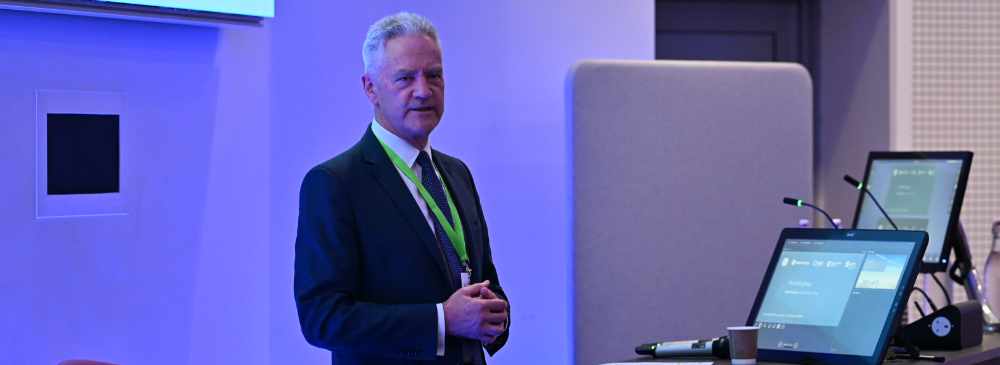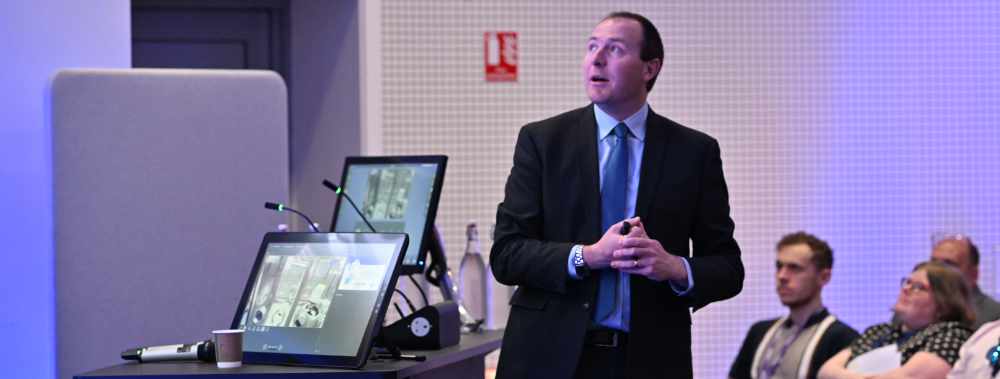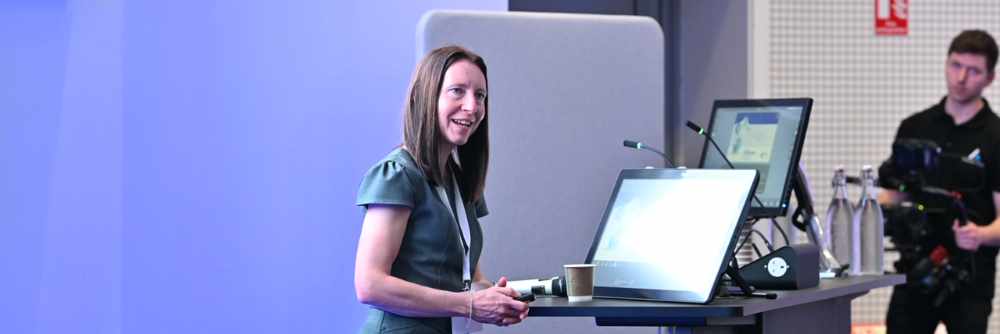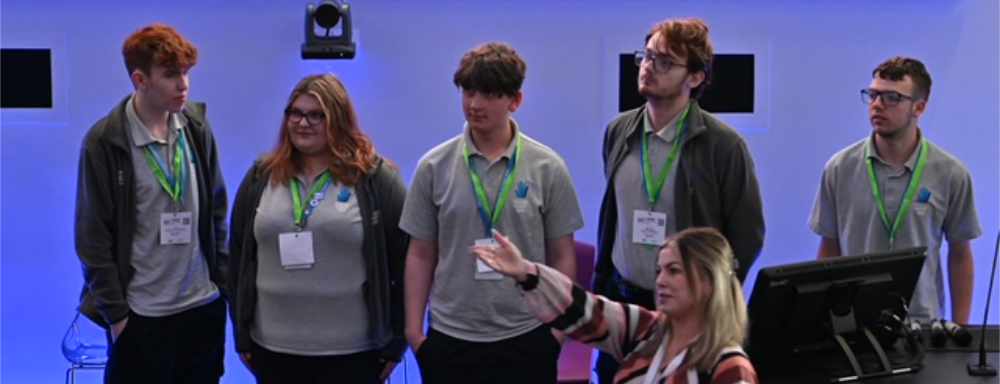Harnessing robotics and AI in challenging environments
“Harnessing Robotics and Artificial Intelligence in Challenging Environments” at Energus, Workington, Cumbria on Tuesday (May 21, 2024).
Contents |
[edit] Robotics and Artificial Intelligence event
A Robotics and Artificial Intelligence event highlighted opportunities to speed up deployment of technology in challenging environments with almost 300 delegates and exhibitors attending the showcase event in Cumbria.
Keynote speakers from across nuclear industry extol virtues of the deployment of Robotics and Artificial Intelligence for safer operations. Highlighting the fact that industries and businesses which fail to embrace the safe deployment of Robotics and Artificial Intelligence to improve their operations may face a similar fate to those who shunned other major technological opportunities such as the Industrial Revolution or the internet.
Attendees heard how embracing robotics and AI can help meet the two global challenges of climate change and energy security.
[edit] UK collaboration RAICo
Delegates heard RAICo, a collaboration between UK Atomic Energy Authority (UKAEA), Nuclear Decommissioning Authority (NDA), Sellafield Ltd and the University of Manchester, plays a vital role, aiding collaboration and bringing the greatest minds together - including end-users, problem-holders and researchers - to find solutions to shared nuclear decommissioning and fusion engineering challenges.
The deployment of robotics and AI was described as being key to accelerating nuclear decommissioning and fusion engineering in a way which delivers missions safer, faster and more cost effectively.
Keynote speakers from the nuclear sector, including Professor Sir Ian Chapman, CEO of the UKAEA; Mr David Peattie, CEO of the NDA; Mr Roddy Miller, Nuclear Operations Director at Sellafield Ltd, and Francis Livens, Professor of Radiochemistry at The University of Manchester, shared with delegates their visions for the safe deployment of the latest technologies.
[edit] Comments
David Peattie said: “I’m passionate about creating opportunities for collaboration across the NDA group, the wider sector, academia and the supply chain and particularly inspiring young people to engage in the work we are doing and develop innovative solutions. We are proud to be part of RAICo and committed to exploring how we can utilise technology and innovation to create a safer working environment for our employees, deliver more effectively and efficiently, to leave a more sustainable legacy for generations to come.”
Roddy Miller said: "Harnessing the power of robotics and AI is not just about technological advancement; it's about creating a sustainable and safer environment for future generations. This event highlighted the incredible potential of these technologies and the important role Cumbria plays in this transformative journey."
During a panel session hosted by Professor Rob Buckingham, Executive Director of the UKAEA, in which keynote speakers were asked their views on risk, Ian Chapman highlighted that, while the safety of operations was paramount, it was also important to consider the risk of industry and businesses failing to adopt technologies which help them achieve some tasks safer, faster and more cost effectively.
Ian Chapman said: “I also consider aggregate risk in conversations like this. The biggest risk for the nuclear sector is that it will cease to exist. Just go back to the Industrial Revolution, or the internet, those (businesses) who decided not to engage, those companies do not exist.”
[edit] Cumbria Robotics Cluster
Engaging with supply chain companies was also highlighted as vital for industries to fully embrace robotics and AI.
The Industrial Solutions Hub (iSH) announced the launch of the Cumbria Robotics Cluster at the event. This cluster brings together organisations with a shared vision to elevate Cumbria as a globally recognised centre of excellence in the field of robotics engineering. RAICo is a founding member of the cluster which is set to play a crucial role in developing advanced robotics technologies and skills that address industrial challenges, particularly in the nuclear industry and other challenging environments.
Dr Kirsty Hewitson, Director of RAICo, said: "This cluster represents a significant opportunity for synergy and innovation amongst Cumbria’s robotics experts and industries. Through this collaborative effort, we are set to map out and expand the capabilities of robotics in the region, driving forward our joint goals of technological advancement and capacity building." Kirsty added: "The supply chain is absolutely crucial to RAICo's success and that broader success across both Sellafield, the wider NDA estate but also the UK Atomic Energy Authority. They (the supply chain) absolutely possess those unique skill sets, technologies that they have developed over many years which we should be tapping into and harnessing and working collaboratively with them. It was great to see a number of those large and small companies come to the event and join in the discussions taking place across the room."
[edit] Social impacts
Organised by FIS360 on behalf of RAICo and its partners, the event also highlighted the social impact of robotics and AI in Cumbria and beyond. Adopting robotics and AI provides opportunities to upskill workforces, create new higher skilled jobs, and offer exciting careers for young people and graduates.
Eleven students aged 16 to 18 from West Lakes Academy and the Energy Coast University Technical College (UTC) who took part in a four-week sprint programme set by RAICo and iSH, to develop a small robot that could move a mock nuclear barrel around a track, shared their learnings and experiences at the event.
Mr Richard Christensen, Senior Mechanical Design Engineer at RAICo, said: “What has been achieved by these talented students in such a short time is incredibly impressive, and watching them speak so confidently (at the event) about their findings was fantastic. At RAICo, we want to champion the next generation of innovators within the robotics and AI industry, providing students and young professionals with opportunities to help them get a foot in the door for a rewarding career.”
[edit] Photos in order
David Peattie, CEO of the Nuclear Decommissioning Authority (NDA), speaking at the “Harnessing Robotics and Artificial Intelligence in Challenging Environments” event at Energus, Workington, Cumbria on Tuesday (May 21).
Roddy Miller, Nuclear Operations Director at Sellafield Ltd, speaking at the “Harnessing Robotics and Artificial Intelligence in Challenging Environments” event at Energus, Workington, Cumbria on Tuesday (May 21).
Professor Sir Ian Chapman, CEO of the UK Atomic Energy Authority, speaking at the “Harnessing Robotics and Artificial Intelligence in Challenging Environments” event at Energus, Workington, Cumbria on Tuesday (May 21).
Dr Kirsty Hewitson, Director of RAICo, who opened the “Harnessing Robotics and Artificial Intelligence in Challenging Environments” event at Energus, Workington, Cumbria on Tuesday (May 21).
Hannah Pears, Education Liaison Officer with iSH, with students who took part in a four-week sprint programme set by RAICo and iSH to develop a small robot that could move a mock nuclear barrel around a track. The students presented their findings and talked about their experiences of the project at the event.
[edit] Related articles on Designing Buildings
- Advanced construction technology.
- Artificial intelligence and civil engineering.
- Artificial Intelligence and its impact on the project profession.
- Artificial intelligence and surveying.
- Artificial intelligence for smarter, safer buildings.
- Artificial intelligence in buildings.
- Artificial intelligence in the construction industry.
- Augmented reality in construction.
- BSRIA publishes Artificial Intelligence in Buildings white paper.
- Building automation and control systems.
- Building information modelling BIM
- Building information modelling and its effect on computer aided manufacture in the UK construction industry.
- Computer aided design CAD.
- Computers in building design.
- Cobots.
- Computer aided manufacturing CAM.
- Computer-generated imagery (CGI).
- ConTech.
- Exoskeleton.
- Generative design.
- Global building automation.
- Information for the buildings of tomorrow.
- Internet of things.
- Mixed reality.
- Parametric design.
- Predictive analytics.
- Prefabrication.
- Robots Are Preparing to Fill 200,000 Vacant Construction Jobs.
- Robots in the construction industry
- The impact of digital on civil engineering.
- Using robots to close the gap between designing and making.
- Virtual construction model.
- Virtual reality and manufacturing.
- Virtual reality in construction.
- Will AI ever be able to design buildings?
Featured articles and news
ECA progress on Welsh Recharging Electrical Skills Charter
Working hard to make progress on the ‘asks’ of the Recharging Electrical Skills Charter at the Senedd in Wales.
A brief history from 1890s to 2020s.
CIOB and CORBON combine forces
To elevate professional standards in Nigeria’s construction industry.
Amendment to the GB Energy Bill welcomed by ECA
Move prevents nationally-owned energy company from investing in solar panels produced by modern slavery.
Gregor Harvie argues that AI is state-sanctioned theft of IP.
Heat pumps, vehicle chargers and heating appliances must be sold with smart functionality.
Experimental AI housing target help for councils
Experimental AI could help councils meet housing targets by digitising records.
New-style degrees set for reformed ARB accreditation
Following the ARB Tomorrow's Architects competency outcomes for Architects.
BSRIA Occupant Wellbeing survey BOW
Occupant satisfaction and wellbeing tool inc. physical environment, indoor facilities, functionality and accessibility.
Preserving, waterproofing and decorating buildings.
Many resources for visitors aswell as new features for members.
Using technology to empower communities
The Community data platform; capturing the DNA of a place and fostering participation, for better design.
Heat pump and wind turbine sound calculations for PDRs
MCS publish updated sound calculation standards for permitted development installations.
Homes England creates largest housing-led site in the North
Successful, 34 hectare land acquisition with the residential allocation now completed.
Scottish apprenticeship training proposals
General support although better accountability and transparency is sought.
The history of building regulations
A story of belated action in response to crisis.
Moisture, fire safety and emerging trends in living walls
How wet is your wall?
Current policy explained and newly published consultation by the UK and Welsh Governments.
British architecture 1919–39. Book review.
Conservation of listed prefabs in Moseley.
Energy industry calls for urgent reform.







